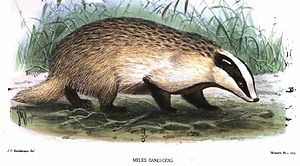Transcaucasian badger
| Transcaucasian badger | ||||||||||||
|---|---|---|---|---|---|---|---|---|---|---|---|---|

Transcaucasian badger ( Meles canescens ) |
||||||||||||
| Systematics | ||||||||||||
|
||||||||||||
| Scientific name | ||||||||||||
| Meles canescens | ||||||||||||
| Blanford , 1875 |
The Transcaucasian badger ( Meles canescens ) is a predator of the marten family and one of four species in the genus Meles . Until recently it was considered a subspecies of the European badger ( Meles meles ). A recent morphological examination of the skull and tooth morphology, and analysis of mitochondrial and nuclear - DNA showed, however, that the Transcaucasian badger species status deserves. Also M. meles arcalus (Crete), M. meles Rhodius (Rhodes) and M. meles severzovi (valleys of the upper Amu Darya and Pjandsch , Fergana Valley and surrounding region in the Pamir - Alai ) were Meles canescens synonymised .
distribution
The Transcaucasian badger is found in the Caucasus (Armenia, Georgia and Azerbaijan), in the foothills of the Caucasus to the north , in Asia Minor , Iran, Iraq, Syria, Lebanon, Israel, in northern Afghanistan, in Turkmenistan , Kyrgyzstan , Uzbekistan and Tajikistan , as well as on the Mediterranean islands of Crete and Rhodes before. East of the Caspian Sea , the Karakum and Kyzylkum deserts separate the range of the Transcaucasian badger from that of the Asian badger ( M. leucurus ). The contact zone of the two species is on the western Tian Shan Mountains. There the Transcaucasian badger lives more in the mountains, while the Asian badger prefers plains and semi-deserts. The contact zone between the distribution areas of the European and the Transcaucasian badger has not yet been clearly defined. In some areas of the foothills of the Caucasus they could occur sympatric and possibly hybridize .
features
The Transcaucasian badger is very similar to the European badger, but a bit lighter and much smaller. The black and white face mask is similar to that of the European badger. The bone capsule formed by the temporal bone and surrounding parts of the middle and inner ear (auditory bulla) is flattened, the snout is shorter, the lower jaw lower. It differs from the Asian badger in the shape of the upper molars (clear notch between metacone and metaconule), larger upper canines , narrower zygomatic arches and a wider auditory bulla. The upper first premolar is often absent, while the lower first premolar is usually present (absent in the Asian badger). The second lower premolar is large and usually has a single, more rarely two, tooth roots . In the European badger, this tooth usually has two tooth roots.
literature
- Alexei V. Abramov, Andrey Yu. Puzachenko: The taxonomic status of badgers (Mammalia, Mustelidae) from Southwest Asia based on cranial morphometrics, with the redescription of Meles canescens. In: Zootaxa . 3681 (1), Jun 2013, pp. 044-058. doi: 10.11646 / zootaxa.3681.1.2
Individual evidence
- ^ J. Marmi, F. López-Giráldez, DW Macdonald, F. Calafell, E. Zholnerovskaya, X. Domingo-Roura: Mitochondrial DNA reveals a strong phylogeographic structure in the badger across Eurasia . (PDF; 553 kB). In: Molecular Ecology. 15, 2006, pp. 1007-1020, doi: 10.1111 / j.1365-294X.2006.02747.x
- ^ I. Del Cerro, J. Marmi, A. Ferrando, J. Jordana, M. Bosch: Inferring the evolutionary history of Meles species: A bayesian approach from multilocus data. Poster presented at Society for Molecular Biology and Evolution 2010 meeting, July 4-8, 2010.